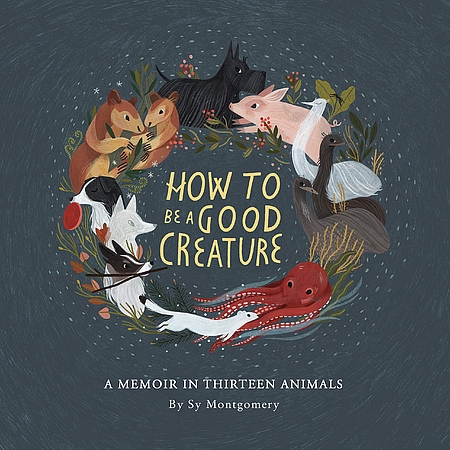“‘Tis a fearful thing, to love what death can touch” (Rabbi Chaim Stern, attributed).
I needed a good short read this summer. Sy Montgomery’s How to be a Good Creature — weighing in at just over 200 pages (roughly 3 hours in audio) — fit the bill. I had flagged it for my To Be Read list years ago, when the title and cover first struck me. The faint nod to Mary Oliver’s famous poem, “Wild Geese” likely helped How to be a Good Creature stick in my mind.
Montgomery titles each of her book’s chapters after an animal – or two, or three – who made a significant impact on her life as a writer, as a naturalist, and as a human being. I especially enjoyed her focus on the uncommon, harder-to-love animals: the bird-eating spider, the tarantula, the octopus. I myself am committed to the lifelong learning experience of being my own good creature, which has manifested as of late in the hair-raising rescue of insects who have found their ways into my spaces through no fault of their own.
At the heart of Montgomery’s book are the border collies with whom she has shared her life: Tess, Sally, and Thurber. Each border collie appeared exactly when they were needed — an experience I share with many of the dogs who have accompanied my own life. Beside them, a pig named Christopher Hogwood. Rescued as a tiny piglet, Chris grew into a 700lb gentle giant.
As I write this, processing the book in its entire, I realize that what irritated me the most about How to be a Good Creature was that far too often the book swung between sneak-preview and overt advertisement for Montgomery’s other adult nonfiction books: The Soul of an Octopus (2015) and The Good Good Pig: The Extraordinary Life of Christopher Hogwood (2006). I got what I could ask for from a short, quick read, but if I had to pick up another one of her books for my introduction to Montgomery, I think I would have picked one of these two instead.
Montgomery loves her animals, despite most of them being long gone from this earth. That’s fine — in fact, that’s great, because (to quote an excellent movie) “Death cannot stop true love.” We humans are so much longer-lived than the animals who join us on our journeys; to be an animal lover is to put a layaway on grief. However, the significant amount of woo-woo (an informal term for what I felt was a mystical and anthropomorphic perspective taken too far) and Montgomery’s wild mood-swings (which would have been better balanced if the book had been single-minded and significantly longer) detracted from my overall enjoyment of an otherwise poignant book.
While I do not believe that Montgomery lived up to her thesis, I did find value in my read. In one of her shortest chapters, “The Christmas Weasel,” Montgomery recounts the story of the time an ermine (a sleek weasel-like animal), who killed one of her beloved hens at Christmastime. What it sorely lacks in stature and size, the ermine makes up for in ferocity and confidence. When Montgomery takes the body of her hen, the little weasel charges at her, enraged at the loss of a good and necessary meal. There’s a wealth of commentary here: the blameless act of an animal doing what an animal must do, humanity’s constant and futile battle to remain separate from nature, and the inseparable nature of life and death.
Sy Montgomery narrates the audiobook, and in my research of her biography, I learned that she was a radio commentator. Her narration is crisp and even, (mostly) properly emotive, and overall well-done. Her performance played out at just the right tempo for an afternoon of sewing.
Sy Montgomery, and Rebecca Green. How to Be a Good Creature : A Memoir in Thirteen Animals. Boston, Houghton Mifflin Harcourt, 2018.


